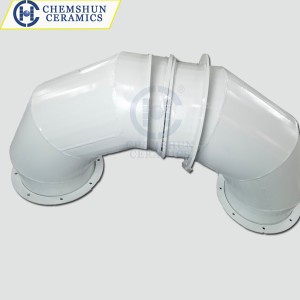During pneumatic conveying, the air flow velocity has a great influence on the degree of wear of chemshun wear-resistant pipes. Since wear is caused by the collision or friction between the air flow and the inner wall of the pipe, the greater the air flow velocity, the greater the energy of the collision or friction, and the more severe the wear. Under the same other conditions, reducing the speed at which the material hits the pipe wall or changing the material impact angle can greatly reduce the wear of the pipe wall. Of course, if the air flow velocity is too low, the conveyed material will be deposited in the pipe and block the pipe. Therefore, a reasonable selection of air flow velocity is the key to ensuring the normal operation of the system.
In pneumatic conveying, the relationship between the amount of wear and the air flow velocity can be expressed as the amount of wear is proportional to the cube of the conveying air flow velocity, that is, the greater the relative speed when the material contacts the pipe wall, the greater the contact pressure formed, the higher the contact frequency generated, and the faster the wear speed of the elbow pipe wall. There are four main reasons for the wear of pneumatic conveying wear-resistant pipes:
(1) Mixing ratio. The lower the mixing ratio of material to air, the more severe the wear.
(2) Flow rate. The higher the flow rate of the material mixed with air in the pipeline, the greater the erosion and wear on the pipe wall.
(3) Material properties. The more abrasive the material is, the more severe the wear.
(4) Selection of pipe diameter and air volume. If the selection is inappropriate, the wear will increase exponentially.
It can be seen that in order to extend the service life of pneumatic conveying wear-resistant pipes, it is necessary to consider the mixing ratio of the conveying materials, flow rate, pipe diameter, etc. Simply increasing the hardness and thickness of the pipe wall is not a fundamental solution to the problem.
Post time: Jun-22-2025


